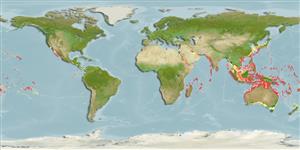Common names from other countries
Environment: milieu / climate zone / depth range / distribution range
Ecologie
marien rifbewoner; diepte 0 - 55 m (Ref. 90102). Tropical
Indo-West Pacific: East Africa to Micronesia, Line Islands, and Society Islands, and Taiwan to Australia (Ref. 90102); including Papua New Guinea, Line Islands and Society Islands; Taiwan to reefs of Coral Sea and New Caledonia (Ref. 54980).
Grootte / Gewicht / Leeftijd
Maturity: Lm ? range ? - ? cm
Max length : 4.0 cm TL mannelijk / geslacht onbekend; (Ref. 48636)
Korte beschrijving
Determinatiesleutels | Morfologie | Morfometrie
Dorsale stekels (totaal) : 13 - 16; Dorsale zachte stralen (totaal) : 7 - 10; Anale stekels: 1; Anale zachte stralen: 15 - 20. Identified by the tall first dorsal fin that is white in males (Ref. 48636). Large individuals may have conspicuous dark spot on upper middle of second dorsal fin connected to a band extending down the sides as well as about 5 darker bars on body and red snout and lower head (Ref. 37816).
Adults are found in various reef habitats, but often on sponges or reef outcrops (Ref. 48636). Also found in intertidal pools (Ref. 13227) and on corals and rocks (Ref. 37816). They feed on zooplankton (Ref. 48636). Eggs are hemispherical and covered with numerous sticky threads that anchor them in the algae on the nesting sites (Ref. 240). Larvae are planktonic which occur primarily in shallow, nearshore waters (Ref. 94114). The most common and most widely distributed among Enneapterygius species (Ref. 90102). Minimum depth reported from Ref. 13227.
Levenscyclus en paargedrag
Maturities | Voortplanting | Spawnings | Egg(s) | Fecundities | Larven
Fricke, R., 1994. Tripterygiid fishes of Australia, New Zealand and the southwest Pacific Ocean (Teleostei). Theses Zool. 24:1-585. (Ref. 13227)
Status op de Rode Lijst van het IUCN (Ref. 130435)
CITES (Ref. 128078)
Not Evaluated
Gevaar voor de mens
Harmless
Gebruik door de mens
Visserij: van geen belang
Tools
Speciale rapporten
Download XML
Internetbronnen
Estimates based on models
Preferred temperature (Ref.
115969): 24.1 - 28.9, mean 27.5 (based on 802 cells).
Fylogenetische diversiteitsindex (Ref.
82804): PD
50 = 0.5000 [Uniqueness, from 0.5 = low to 2.0 = high].
Bayesian length-weight: a=0.00562 (0.00258 - 0.01228), b=3.08 (2.89 - 3.27), in cm Total Length, based on LWR estimates for this (Sub)family-body shape (Ref.
93245).
Trofisch niveau (Ref.
69278): 3.4 ±0.45 se; based on food items.
Weerstandsvermogen (Ref.
120179): Hoog, minimale populatieverdubbelingstijd minder dan 15 maanden (Preliminary K or Fecundity.).
Fishing Vulnerability (Ref.
59153): Low vulnerability (10 of 100).
